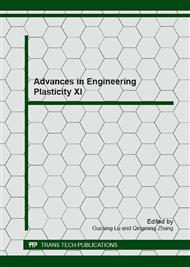p.117
p.121
p.125
p.129
p.133
p.137
p.141
p.147
p.152
Effect of Temperature on the Dynamic Compressive Properties of Magnesium Alloy AZ91D
Abstract:
Lightweight materials are getting more and more attraction towards their use in automobiles, planes, protective structures, electronics and supports for numerous benefits ranging from reduction in fuel consumption in vehicles to lighter and stronger in protective structures. For efficient use of materials in applications where they are subjected to unusual higher sudden loads and varying temperatures, it is necessary to know their accurate response under such conditions. Magnesium alloys due to low density, high specific strength, high specific stiffness and damping capacity have been in use for variety of structural and non-structural applications mainly in automotive and aerospace industries along with many other applications in defense, supports and electronics. In present study, the effect of temperature variation has been investigated for magnesium alloy AZ91D at high strain rates. The temperature is varied in the range between -30oC to 200oC at a strain rate of 103 s-1. Lower stresses and larger strains to peak compressive stresses are observed with increasing temperature. At higher strain rate, the effect of temperature on the alloy’s hardening behaviour is less significant
Info:
Periodical:
Pages:
133-136
Citation:
Online since:
January 2013
Authors:
Price:
Сopyright:
© 2013 Trans Tech Publications Ltd. All Rights Reserved
Share:
Citation:


